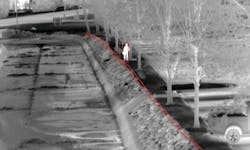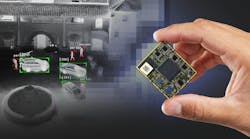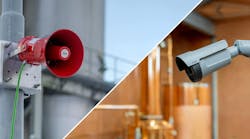When coupled with optimized thermal video analytics, thermal cameras have been recognized as one of the most effective perimeter intrusion detection tools for years, but their cost often required customers to reserve them for their most sensitive or vulnerable installations.
Now that thermal cameras that once cost tens of thousands of dollars can be had for as little as $500, the implications for security dealers and integrators are profound.
Because they are dramatically more affordable, and that they do not require the installation of auxiliary lighting infrastructure, a “perfect storm” of affordability, capability and return on investment is exposing an entirely new layer of perimeter security markets for security dealers and integrators.
Growing Markets
An example of this deployment expansion can be seen in electrical substation security. While the efficacy of thermal cameras and analytics has not been in doubt, their cost has kept facility managers from placing multiple cameras around the perimeter of every substation within their charge. Instead, thermal has been reserved for the substations that were the most remote or the most vulnerable to theft and damage.
With their lower acquisition costs, however, the industry has been seeing many more mass deployments of thermal cameras to substations, and around the rest of the security markets.
Other factors at play, in addition to their lower entry cost, are the fact that thermal cameras are passive, effective around the clock, require no lighting, and provide effective threat assessment when an alarm is triggered.
This is a unique collection of attributes, especially when the monitoring facilities are far removed from the site at risk and accurate assessment is vital to the formation of a valid and effective response.
While electrical substation security is an excellent example of how security dealers and integrators can see these low-cost thermal cameras proliferating in the coming months, partly due to FERC and NERC regulations, these same attributes apply to other security scenarios as well.
Car dealerships and large parking areas are potential markets that have historically not had access to thermal cameras due to their cost. Now, however, they are seeing that thermal cameras and analytics are as cost effective, or even more so, than other intrusion detection technologies.
The same holds true for other large areas that need better video security and surveillance. Rooftops, for example, are notoriously vulnerable to intrusion and would benefit greatly from this passive, persistent security technology that can provide both detection and assessment capability in the same sensor — the thermal camera with analytics.
Technology Comparison
For those who are not up on the recent developments in thermal technology, the immediate reaction is often to dismiss them as too expensive, especially when compared to using visible cameras with lights or infrared illuminators. Keep in mind that thermal camera accessories for the iPhone are now out there for $350 and thermal security cameras start at $500.
Daylight Visible Light Cameras: Visible light cameras are effective tools for security and surveillance applications; however, just like the human eye, visible light cameras do not see very well in total darkness. In order to detect intruders at night, they need additional lighting infrastructure to provide the illumination they need.
It takes a surprising amount of expensive work to hang a light bulb. Poles need to be embedded in the earth and fixed in place. Trenches for power and control cables need to be dug, and the wiring itself needs to be run, protected and installed. Regardless of how efficient the bulb technology being used may be (fluorescent lamps, HID lamps), the installation cost is still very high.
Powering and maintaining the lights can even be more costly. In addition to the power costs required, bulb replacement costs include significant labor and material costs that will continue for the life of the program.
Even with all of these added costs, lighting does not necessarily create a more secure facility. Light can only penetrate a certain distance and completely illuminating an area, so that it can be kept under surveillance by visible light cameras, is not always possible. Furthermore, lighting essentially lays out a route of attack for intruders, creating shadows in which they can hide and access undetected.
Visible Light Cameras with Infrared Illumination: While some are attracted to infrared illumination to help cameras perform better at night, they have many of the same downfalls as regular flood lighting. Plus, infrared illuminators suffer from limited range performance, and they are not easily fitted to dome cameras because of technical challenges involved that impact efficacy and durability.
Thermal Advantages
For those unfamiliar with how they work, thermal security cameras let people see what their eyes cannot: invisible heat radiation emitted by all objects regardless of lighting conditions. Thermal cameras detect the minute temperature differences between objects, and turn them into video that displays on almost any TV monitor.
Because they see heat, not light, thermal cameras are effective threat detection tools in any environment. They can easily detect intruders and other potential hazards to the security of people and infrastructure in any weather, as well as all day and all night.
Thermal cameras are more effective than visible cameras for intrusion detection and analytics day and night, but their total cost of ownership is often much less than visible cameras, even if the acquisition cost may be a little more.
This is for a number of reasons. First, they do not require any of the lighting infrastructure that visible cameras do, so both the installation and ongoing operational costs are saved. But even more important, a thermal camera’s effective nighttime detection range is often much greater than an infrared illuminated camera, so the same area or fence line can be covered with a fraction of the cameras, thus further reducing overall costs.
These are all factors that make low-cost thermal cameras able to open significant potential markets for dealers and integrators in the near future.
David Lee is a technical writer for FLIR. To request more info about the company, please visit www.securityinfowatch.com/10213696.



